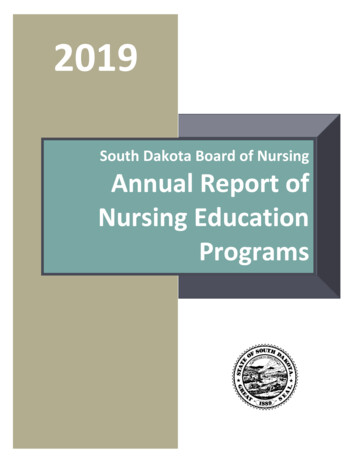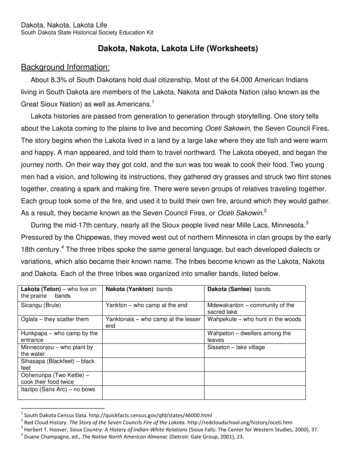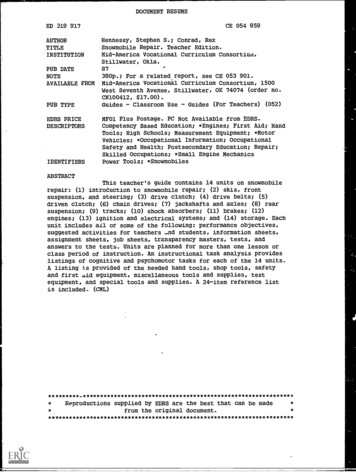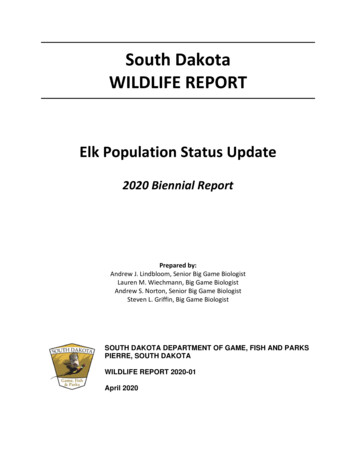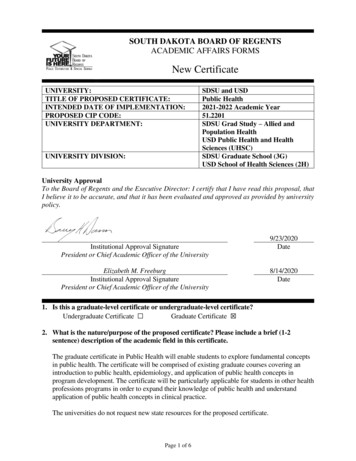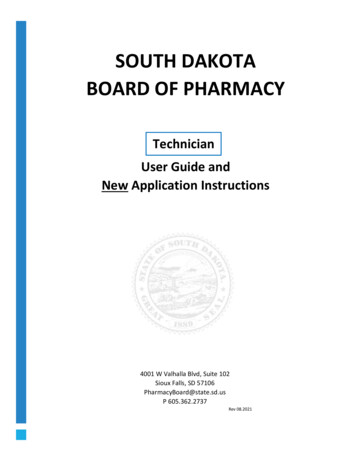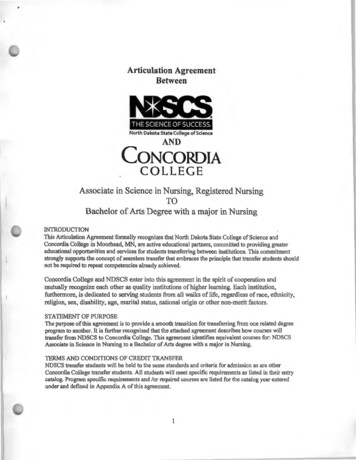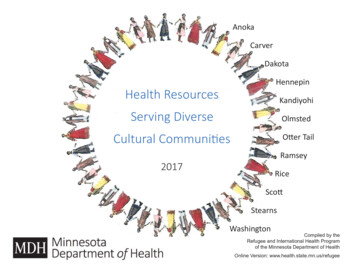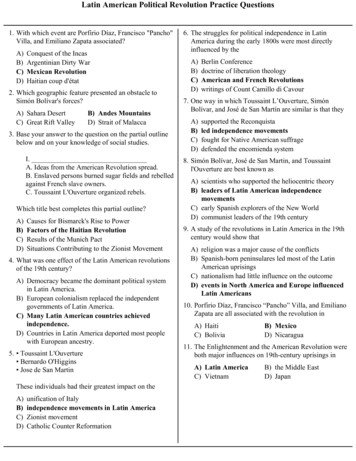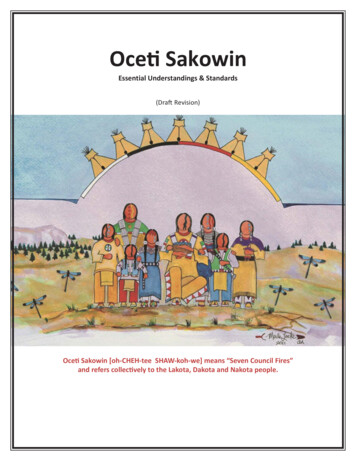
Transcription
Oceti SakowinEssential Understandings & Standards(Draft Revision)Oceti Sakowin [oh-CHEH-tee SHAW-koh-we] means “Seven Council Fires”and refers collectively to the Lakota, Dakota and Nakota people.
TABLE OF CONTENTSHistory of Development of the Oceti Sakowin Essential Understandings and Standards. . . . . . . . . . . . . . . . . . . . . . . . . . . . . . . 1OSEU at a Glance. . . . . . . . . . . . . . . . . . . . . . . . . . . . . . . . . . . . . . . . . . . . . . . . . . . . . . . . . . . . . . . . . . . . . . . . . . . . . . . . . . . . . . . . . 3OSEU 1 . . . . . . . . . . . . . . . . . . . . . . . . . . . . . . . . . . . . . . . . . . . . . . . . . . . . . . . . . . . . . . . . . . . . . . . . . . . . . . . . . . . . . . . . . . . . . . . . . 4OSEU 2 . . . . . . . . . . . . . . . . . . . . . . . . . . . . . . . . . . . . . . . . . . . . . . . . . . . . . . . . . . . . . . . . . . . . . . . . . . . . . . . . . . . . . . . . . . . . . . . . . 6OSEU 3 . . . . . . . . . . . . . . . . . . . . . . . . . . . . . . . . . . . . . . . . . . . . . . . . . . . . . . . . . . . . . . . . . . . . . . . . . . . . . . . . . . . . . . . . . . . . . . . . . 8OSEU 4 . . . . . . . . . . . . . . . . . . . . . . . . . . . . . . . . . . . . . . . . . . . . . . . . . . . . . . . . . . . . . . . . . . . . . . . . . . . . . . . . . . . . . . . . . . . . . . . . 10OSEU 5 . . . . . . . . . . . . . . . . . . . . . . . . . . . . . . . . . . . . . . . . . . . . . . . . . . . . . . . . . . . . . . . . . . . . . . . . . . . . . . . . . . . . . . . . . . . . . . . . 12OSEU 6 . . . . . . . . . . . . . . . . . . . . . . . . . . . . . . . . . . . . . . . . . . . . . . . . . . . . . . . . . . . . . . . . . . . . . . . . . . . . . . . . . . . . . . . . . . . . . . . . 14OSEU 7 . . . . . . . . . . . . . . . . . . . . . . . . . . . . . . . . . . . . . . . . . . . . . . . . . . . . . . . . . . . . . . . . . . . . . . . . . . . . . . . . . . . . . . . . . . . . . . . . 17OSEU Standards with Suggested Approaches for Instruction . . . . . . . . . . . . . . . . . . . . . . . . . . . . . . . . . . . . . . . . . . . . . . . . . . . . 19History Tables of the Oceti Sakowin & Teton. . . . . . . . . . . . . . . . . . . . . . . . . . . . . . . . . . . . . . . . . . . . . . . . . . . . . . . . . . . . . . . . . . 21Current Locations of Oceti Sakowin Bands . . . . . . . . . . . . . . . . . . . . . . . . . . . . . . . . . . . . . . . . . . . . . . . . . . . . . . . . . . . . . . . . . . . 30Map of South Dakota Reservations . . . . . . . . . . . . . . . . . . . . . . . . . . . . . . . . . . . . . . . . . . . . . . . . . . . . . . . . . . . . . . . . . . . . . . . . . 31Glossary of Terms . . . . . . . . . . . . . . . . . . . . . . . . . . . . . . . . . . . . . . . . . . . . . . . . . . . . . . . . . . . . . . . . . . . . . . . . . . . . . . . . . . . . . . . 32Bibliography. . . . . . . . . . . . . . . . . . . . . . . . . . . . . . . . . . . . . . . . . . . . . . . . . . . . . . . . . . . . . . . . . . . . . . . . . . . . . . . . . . . . . . . . . . . . 33About the Cover Artist: Merle LockeMerle is an Oglala Lakota artist who resides in Porcupine, South Dakota. His paintings are very symbolic in nature depictingtraditional tribal scenes and imagery. The symbolism of the cover painting for the Oceti Sakowin Essential Understandingsand Standards Project is representative of several meanings. The Oceti Sakowin tradition of oral teaching among generationsis depicted by showing an elder in the center. The elder is surrounded by seven people who represent different generations.The people, as well as the seven tipis, represent the Oceti Sakowin (Seven Council Fires). The dragon flies represent hope andprosperity with the thoughts of bringing goodness to the tribes and people.
A HISTORY OF THE DEVELOPMENT OF THEOCETI SAKOWIN ESSENTIAL UNDERSTANDINGS AND STANDARDS“The hope is that citizens who are well educated about the Oceti Sakowin history and culture will be more likely to makebetter decisions in the arena of Indian issues and to get along better with one another.”- Lakota Scholar, Dr. Craig Howe 2010CORE CONCEPT WORK GROUP - 2008-2010The Core Concept development was the first phase of the project which began in 2008, and was completed in August2010. The development team consisted of a diverse group of individuals from across the state. This included educators ofAmerican Indian students in public school districts with both a high and low population of American Indian students. Inaddition, there were experts in culture, history, oral traditions and language along with Department of Education staff. Thegoal of the first phase of the project was to identify core concepts that are essential to understanding and teaching of theOceti Sakowin history and culture.Team Members Earl BullheadGladys HawkCorrie Ann CampbellStephanie Charging Eagle Danny SeaboyRobert Two CrowLydia Whirlwind SoldierMarcia Zephier Ann RobertsonStuart ZephierDorothy LeBeauDorothy Kiyukan Terry JanisBrinda KuhnDr. Craig HoweKeith MooreDr. Kim Cypher“Opening yourself to another worldview will assist you in understanding of what occurs both in and outside of nativecommunities.” - Lakota Elder and Educator, Dottie LeBeau 2012ESSENTIAL UNDERSTANDINGS WORK GROUP - 2010-2012Upon completion of the identification of the Oceti Sakowin Core Concepts, a smaller work group was created to developessential understandings and standards. The group was comprised of members of the original group who had experiencein writing standards and one American Indian Studies teacher from a public school district that served a high numberof non-Native students. The group consulted with Montana’s Office of Indian Education and the Indian Land TenureFoundation’s standards work. The format created for the development of the work was designed to provide compatibilityto the South Dakota social studies standards. The essential understandings captured the core concepts that weredeveloped by the larger group. Indicators, standards and activities were written to provide a framework for additionalwork and various forms of implementation. Culturally appropriate work created by other sources was identified to supportsuggested activities.Team Members Stephanie Charging Eagle Lydia Whirlwind Soldier Dorothy LeBeau Earl Bullhead Dan Snyder Corrie Ann Campbell Gladys Hawk Duane Hollow Horn Bear Victor Douville Dr. Clifford Canku Danny Seaboy Roger Campbell“Essential Understandings will address cultural diversity, provide many new insights and concerns of local Tribalcommunities, and address challenges faced by educators and families of students. Education will be much better as aresult of the commitment of schools, administrators and educators for meaningful engagement to raise consciousness toappreciate and respect cultural differences that will empower Native American students.”- Lakota Elder, Lydia Whirlwind Soldier 2012Proposed Draft - September 14, 2017 - Public Hearings occurring 2017-18 with Proposed Adoption Spring 2018Page 1
2012 REVISIONSThe document was revised in 2012 to include a summary introduction for each essential understanding. Additionalhistorical information about the bands of the Oceti Sakowin was included, as well as the current location of those bands. Asong with its historical information was included for each essential understanding. The primary goal for the additions wasto increase the knowledge base of educators in order to assist them in the teaching and sharing of their material in theclassroom.Team Members Lydia Whirlwind Soldier Stephanie Charging Eagle Dorothy LeBeau Earl Bullhead Dan Snyder Corrie Ann Campbell, Facilitator2011-2016 DEVELOPMENT OF WOLAKOTA PROJECT INTERVIEWS AND WEBSITEwww.wolakotaproject.org2015 DEVELOPMENT OF SOCIAL STUDIES “CONNECTOR ose.aspx2016 REVIEW, REVISION AND LESSON PLAN TEAM Joyce BlaasStephanie Charging EagleAngela DebnerSage Fast DogMichael KaneValerie Knauer Loretta (Lori) KokesDorothy /Dottie LeBeauJeannine MetzgerCortney MistelskiMichelle Nelin-MaruaniOlivia Olson Christian PirletJeannette SchroederGabrielle SeeleyDeanna StandsLeeVi StoryCarolyn Tail Lydia Whirlwind SoldierVictor DouvilleDuane Hollow Horn BearGladys HawkSam ShawScott SimpsonSharla SteeverSD OSEU aligned social studies lessons can be accessed at: standards.Camp. (1870). Sioux (Minneconjou Lakota). Fort Sully, Cheyenne River Reservation in South Dakota [Photograph].Smithsonian-NMAI. Used with permission.Page 2Proposed Draft - September 14, 2017 - Public Hearings occurring 2017-18 with Proposed Adoption Spring 2018
OSEU AT A GLANCEOSEU 1: LANDS & ENVIRONMENTThe original land base and natural resources of the Oceti Sakowin [oh-CHEH-tee SHAW-koh-we] were under communalstewardship prior to immigrant settlement. Oceti Sakowin have a distinct and unique interrelationship with theenvironment that is essential to South Dakota.OSEU 2: IDENTITY & RESILIENCYThere is variety and resiliency among individuals within the Oceti Sakowin [oh-CHEH-tee SHAW-koh-we] Oyate [oh-YAHtay] (people) as identity is developed, defined and redefined by entities, by organization, and by people. A continuum oftribal identity, unique to each individual, ranges from assimilated to traditional lifestyle. There is no “generic AmericanIndian.”OSEU 3: CULTURE & LANGUAGEThe origin, thought and philosophy of the Oceti Sakowin [oh-CHEH-tee SHAW-koh-we] continues in the contemporarylifestyles of Tribal members. Tribal cultures, traditions and languages are incorporated and observed by many Tribalmembers both on and off the reservations.OSEU 4: KINSHIP & HARMONYOceti Sakowin [oh-CHEH-tee SHAW-koh-we] kinship systems provide a framework for both individual and group behavior.Its unwritten rules promote harmony, compromise, a sense of order, and group cohesion.OSEU 5: ORAL TRADITION & STORYHistory told from the Oceti Sakowin [oh-CHEH-tee SHAW-koh-we] perspective, through oral tradition and writtenaccounts, frequently conflicts with the stories told by mainstream historians. An analysis of multiple perspectives revealshistory in a more inclusive and accurate way.OSEU 6: SOVEREIGNTY & TREATIESFederal policies and treaties put into place throughout American history have affected Oceti Sakowin [oh-CHEH-teeSHAW-koh-we] people adversely. Tribes as sovereign nations have the authority to enter into government to governmentrelationships. Currently, the relationship between each tribe, their state(s), and the federal government is not the samefor each tribe.OSEU 7: WAY OF LIFE & DEVELOPMENTThe essential philosophy of the Oceti Sakowin [oh-CHEH-tee SHAW-koh-we] wicoun [wee-CHO] (way of life) is based onthe values of the Oceti Sakowin which have created resiliency of the Oyate [oh-YAH-tay] (people). Tribal communitieshave put considerable effort into education and economic development, Tribal universities and colleges, wellness centers,cultural traditions, and language revitalization.Proposed Draft - September 14, 2017 - Public Hearings occurring 2017-18 with Proposed Adoption Spring 2018Page 3
OSEU 1: LANDS & ENVIRONMENTThe original land base and natural resources of the Oceti Sakowin [oh-CHEH-tee SHAW-koh-we] were under communalstewardship prior to immigrant settlement. Oceti Sakowin have a distinct and unique interrelationship with theenvironment that is essential to South Dakota.OCETI SAKOWIN ESSENTIAL UNDERSTANDING 1, PK-12 STANDARDS Standard 1.1 – Identify changes from the historic land base to the contemporary nine-reservation South Dakota landbase of the Oceti Sakowin, and analyze the causes and implication of those changes. Standard 1.2 – Describe traditional and contemporary Oceti Sakowin perspectives on communal stewardship of landand natural resources (flora, fauna, geographic and sacred features). Standard 1.3 – Demonstrate understanding of the interrelationships of Oceti Sakowin people, places, and environmentswithin all tribal lands in South Dakota. Standard 1.4 – Identify and explain contemporary environmental issues facing Oceti Sakowin lands. Standard 1.5 – Examine strategies the tribal governments and other tribal leaders are taking to improve the lands andnatural gifts of Oceti Sakowin people.OCETI SAKOWIN ESSENTIAL UNDERSTANDING 1 EXTENDED DESCRIPTIONOceti Sakowin (historically, known to some as the Sioux Nation) is a Native confederacy speaking three different dialects:the Lakota, Dakota and Nakota. The Lakota are the largest of the three groups, composed of seven bands living primarilyin South and North Dakota. The Dakota or Santee, composed of five bands live primarily in South Dakota, Minnesota andNebraska. The Nakota, composed of three bands live primarily in South Dakota and Montana.Native inhabitants of America did not have a concept of individual land ownership. This was an intrinsically foreign conceptto the customs and beliefs of Oceti Sakowin. Oceti Sakowin land was enjoyed and used in common by all members of thetribe for survival and sustenance. Communal tenure was a principle and norm of each tribe who established boundariesin the territories on which they lived. They defended these boundaries from encroachment by other tribes and later byforeigners. Every member of the tribe born into the group had a lifelong right to live on that land and became a custodianto preserve and protect the land for the future generations.Oceti Sakowin were nomadic and moved from area to area in their territory when needs arose. Europeans brought withthem laws governing private land ownership that conflicted with traditional tribal customs and communal land tenure. Landloss and the creation of reservations for Oceti Sakowin could be traced to the aftermath of European immigrant contact.Immigrants continued to push west into Oceti Sakowin home lands resulting in wars and major battles. Treaties weresigned, by tribes and the U.S. government, and subsequently broken mostly because of land issues. A government togovernment relationship was established to protect the rights and resources under tribal stewardship and is still supportedby the United States Constitution.Oceti Sakowin tribal groups’ broad philosophical and holistic view on communal land enterprise and philanthropycontinues. Sharing and giving for the benefit of all, are concepts that are deeply rooted in the culture of Oceti Sakowin. Inthe midst of great adversities, the resiliency of the Oceti Sakowin indicates a proud people, still living, and striving by theircenturies old modes and manners through generations, keeps them the great people they are today. Communal practices,processes and land holdings are still an all-encompassing traditional culture of the Oceti Sakowin. (L. Whirlwind Soldier 2012)Page 4Proposed Draft - September 14, 2017 - Public Hearings occurring 2017-18 with Proposed Adoption Spring 2018
OCETI SAKOWIN ESSENTIAL UNDERSTANDING 1 SONGEvery individual tiospaye (band) had their own song. Songs were modified and reused for different occasions. This songwas shared by Porcupine singers at Vermillion, S.D. in 1979 in honor of Joe Louis Bullhead. It was used as a memorialsong. I was once told that this song came out of Bullhead South Dakota. It is said that Old Man Straw Shoot and Joe BraveThunder used to sing this song. (E. Bullhead 2012).Wokiksuye Olowan wan(A memorial song)Kola weksuyeye kola weksuyelo he ye yelo(Friend) (I remember) (Friend) (I remember)Kola weksuyeye kola iyapelo he ye ye yelo(Friend) (I remember) (Friend) (They have gone)Maka sitomniya akicita ye na he owakiye(All over the world) (Soldier) (Went) (That) (I’m helping)Tuwe sece k’un kola weksuye kola iyapelo he ye yelo(To whom it may concern) (Friend) (Remember) (Friend)(They have gone)Maka sitomniya akicita ye na he owakiyelo he ye yelo(All over the world) (Soldiers went) (I’m helping)Free Translation: We are honoring all those relatives who havegone to protect our freedom. (Individual’s Lakota name)I remember my friend. They have been all around the world.(E. Bullhead 2012)Tipi. (1884). Brule Sioux (Sicangu Lakota) RosebudReservation, South Dakota at the bequest of De Cost Smith[Photograph]. Smithsonian-NMAI. Used with permission.Funeral of Albert Grass. (n.d.). Funeral of Albert Grass-Killed in France-Hereditary Chief of the Sioux (Sihasapa,Lakota), K. Clergymen, casket, father and mother [Photograph]. Smithsonian-NMAI. Used with permission.Proposed Draft - September 14, 2017 - Public Hearings occurring 2017-18 with Proposed Adoption Spring 2018Page 5
OSEU 2: IDENTITY & RESILIENCYThere is variety and resiliency among individuals within the Oceti Sakowin [oh-CHEH-tee SHAW-koh-we] Oyate [oh-YAHtay] (people) as identity is developed, defined and redefined by entities, by organization, and by people. A continuum oftribal identity, unique to each individual, ranges from assimilated to traditional lifestyle. There is no “generic AmericanIndian.”OCETI SAKOWIN ESSENTIAL UNDERSTANDING 2, PK-12 STANDARDS Standard 2.1 – Demonstrate knowledge of the Oceti Sakowin people’s understanding of the interrelationship ofspiritual, physical, social and emotional health. Standard 2.2 – Describe the impact of Euro-American ideals, values, rights, philosophy, and beliefs, upon OcetiSakowin people as tribal, state, and US citizens. Standard 2.3 – Recognize that there is a continuum of tribal identity, ranging from assimilated to traditional lifestyle,that includes each unique subculture or individual member within the Oceti Sakowin.OCETI SAKOWIN ESSENTIAL UNDERSTANDING 2 EXTENDED DESCRIPTIONEnvironment has a tremendous influence on Oceti Sakowin lifestyles. There is a distinct difference between the tribeswho live in the woodland areas and those who live on the plains. Much like all other cultural groups in American society,individual differences within tribal groups vary. Variations of individual differences within any cultural group are influencedby assimilation into society at large, language other than the Native language, upbringing, personal relationships,life experiences, and socioeconomics. However, assimilation efforts by the United States government and religiousorganizations as early as 1790 contributed to drastic changes in tribal society and to individual differences.Americanization policies were based on the idea that when indigenous people learned (European-American) customsand values they would be able to merge tribal traditions with European-American culture and peacefully join the majoritysociety. After the end of the Indian Wars, in the late 19th and early 20th centuries, the government outlawed the practiceof Native American traditional religious (spiritual) ceremonies. It established boarding schools and children were takenfrom their homes and families and attendance in boarding schools was mandatory. In these schools the children wereforced to speak only English, study standard subjects, attend church, and leave their traditions behind. (Adams, DavidWallace 1995)These mandated policies created forced change for individuals and individual Oceti Sakowin families. The boardingschool system contributed greatly to the erosion of tribal culture that reverberates into this century, causing many socialdysfunctions and in some cases disillusion in American society. After 1890 the tribes continued to resist forced assimilationpassively, by simply refusing to forfeit their cultures. The spiritual ceremonies went underground and were held insecrecy. Oceti Sakowin language was still spoken in the home when children returned from boarding school. However,not all families resisted the changes; some willingly accepted the assimilation policies of the government and religiousorganizations.Despite individual differences that do exist within tribal groups, Oceti Sakowin people strongly identify with their tribalgroup through enrollment into the tribe, common origin, history, culture, and language.If the general public assumes that there is a “generic American Indian,” then that assumption carries with it society’svisible injustice of stereotyping, racism, and other forms of prejudice and discrimination. In South Dakota, it is mostrespectful to say “Oceti Sakowin,” or, depending on the dialect group from which they come, to say “Dakota,” “Nakota,”and “Lakota” people.As a country of diverse cultures we have cultural knowledge that we can share positively and constructively with eachother. By honoring and respecting each culture’s perspectives, ideas, differences, and similarities we can create a better,stronger, and more peaceful American society. (L.Whirlwind Soldier 2012)Page 6Proposed Draft - September 14, 2017 - Public Hearings occurring 2017-18 with Proposed Adoption Spring 2018
OCETI SAKOWIN ESSENTIAL UNDERSTANDING 2 SONGThis song connects with Essential Understanding 2 in several ways, including but not limited to: First, the speaker isasserting his individual identity by saying, “it’s me.” He is personally choosing to have his picture taken. Second, this songacts as an example of acculturation by choice. It depicts the resiliency of an individual who has experienced a facet ofanother culture and is choosing to use that new facet as a way to stay connected to his relative.Love, family, and transition are communicated through this song. Originally people felt that because pictures could capturea person’s spirit, photographs should not be taken. They called photographers “shadow catchers.” As times changed, sodid the viewpoint for many on the concept of photos and the photographer. The new perspective allowed people to usephotographs as reminders of loved ones. The song, part of the National Archives in the Washington, D.C., is evidence ofthe change in belief about photography. (E. Bullhead 2012)Wo I ste Olowan wanA love song (itowapi)Itowapikile yuha nameaksuyaya he miyeyeyelo heyeyeye(This picture) (With) (Remembering me) (It’s me)Since Itowapikile yuha nameaksuye he miyeyelo heyeyeyo(Brother-in-law) (This picture) (Remember me) (It’s me)Wamayalankinktaye since itowapike le yuha nameaksuyaya(You will be able to see me) (Brother-in-law) (With this picture)(Remember me)He miyeyelo heyeyeyo(That’s me)Free Translation: With this picture always remember me; it is I,Brother-in-law, with this picture remember me. It will be a longtime before you see me again, so every day you will see me.Brother-in-law with this picture remember me, it is me!(E. Bullhead 2012)Upton, Benjamin Franklin. (n.d.). Woman and children,wife and children of condemned Sioux Chief, Possiblyre: Minnesota Massacre of 1862 St. Paul [Photograph].Smithsonian-NMAI. Used with permission.Woman with two children cooking in 1950’s style kitchen. (1956). Mrs. Floyd Roubideaux, with her two children in the kitchen oftheir apartment. Mrs. Roubideaux’s family was originally from Rosebud, South Dakota, and came to Gary in January of 1956, whereMr. Roubideaux was employed as a trainee for a steel company. The family, Sicangu Lakota, lives in one of the housing projects on theout skirts of Gary, Indiana. [Photograph]. Smithsonian- NMAI. Used with permission.Proposed Draft - September 14, 2017 - Public Hearings occurring 2017-18 with Proposed Adoption Spring 2018Page 7
OSEU 3: CULTURE & LANGUAGEThe origin, thought and philosophy of the Oceti Sakowin [oh-CHEH-tee SHAW-koh-we] continues in the contemporarylifestyles of Tribal members. Tribal cultures, traditions and languages are incorporated and observed by many Tribalmembers both on and off the reservations.OCETI SAKOWIN ESSENTIAL UNDERSTANDING 3, PK-12 STANDARDS Standard 3.1 – Identify similarities and differences among the Lakota/Dakota/Nakota language dialects. Standard 3.2 – Describe efforts made by Tribal members on and off the reservation to revitalize Oceti Sakowin languages. Standard 3.3 – Recall Oceti Sakowin sacred sites, creation stories, and star knowledge and describe how they relate toeach other, and how they are still used today on and off the reservation. Standard 3.4 – Identify Oceti Sakowin songs and categorize them by appropriate context (ceremony songs, honoring/celebration songs, and wacipi / powwow songs).OCETI SAKOWIN ESSENTIAL UNDERSTANDING 3 EXTENDED DESCRIPTIONOceti Sakowin origin, thought and philosophy continues to be vibrant, strong and taught to the younger generation today.It is an abstract perspective of living in harmony with creation. Oceti Sakowinphilosophy is embedded in the Oceti Sakowin language, in the origin stories, in thevalues and ethics, in the kinship system and social relationships, in the relationshipwith the environment and with all living things. It is a way of teaching the values ofrespect, honor, responsibility, positive family and personal relationships, humility,reciprocity, sharing and much more. This is a way of thinking about creation, theuniverse and the people.Child in traditional clothing. (1922).Gift of Charles P. Eaton [Photograph].The relationships among the people, the Creator, Mother Earth, and all of naturewas, (and still is) significant in the lives of Native peoples. The Oceti Sakowin Oyatebelieve that all things are part of the great whole. As such, plants and animalsbecome our relatives. Respect for plants and animals was, (and still is) shown bythanking the spirits of these elements for the gifts of themselves, which providefor the physical needs of the Oyate. The Oceti Sakowin Oyate hunted and gatheredplants and animals for food and clothing, only when necessary. Nothing was wasted,as this would be disrespectful of the gifts given to sustain life. (Eastman, 1976;Standing Bear, 1975) (D.LeBeau 2012) “Only take from the land what it is willing togive.” Never take more and always give back in some way. Most indigenous peopleknow and understand this concept.Traditionally, Oceti Sakowin people express their traditions and reinforce this tightlywoven relationship with the world through teachings, examples, ceremonies andprayers. It is integrated into ideas, experiences, wisdom, traditions, language and customs. This existential relationshipwith the environment has evolved through direct experience and contact through centuries of interaction with ecosystemsand the environment at large.Smithsonian-NMAI. Used with permission.In Oceti Sakowin cosmology, “everything in the natural world has relationships with every other thing and the total setof relationships makes up the natural world as we experience it” (Deloria, 1992). For that reason, the prayer--MitakuyeOyasin—meaning “All my relatives.” We are all related and not only are we related, we are closely linked in a symbioticrelationship. This familial circle of life ties the Oceti Sakowin to all life forms-- everything above, everything below,everything between. (V. Douville, 2010) (D.LeBeau 2012) To teach and understand that creatures, man, animals, birds,insects, reptiles, plants, water, and air are integral to the survival of the people and earth as we know it is the heart of theculture. Mitakuye Oyasin reflects the physical, mental, spiritual, emotional and intuitive relationship that the Oceti Sakowinhas with all aspects and elements of the environment.Page 8Proposed Draft - September 14, 2017 - Public Hearings occurring 2017-18 with Proposed Adoption Spring 2018
There is a clear distinction between spirituality and structured religion. Spirituality is an experience that is lived on a dailybasis. There is no word for religion in the Lakota, Dakota, or Nakota language. It is “doing it in a good way, with dignity,integrity and honor, and with honesty.” (Ida Hildebrand)In understanding Oceti Sakowin perspective we must teach all children to better understand, respect and honor theenvironment, natural resources and to work in collaboration, cooperation and to develop a partnership to preserve thatwhich will sustain the coming generations. Acknowledgement and acceptance that there is wisdom in the traditionalknowledge and teachings of indigenous people will teach children stronger and more comprehensive environmentpractices that could very well ensure their future. This is an opportunity to recognize similarities while honoring andrespecting the differences in cultures, traditions and beliefs. (L. Whirlwind Soldier 2012)OCETI SAKOWIN ESSENTIAL UNDERSTANDING 3 SONGWe have to remember to look up and humble ourselves. We have to remember that there is an existence in the stars andabove. This song reminds us to do that.This composition was done by Earl Bullhead while traveling together with Jimmy Dan Dog Eagle, right after the Sundanceat Sitting Bull camp, also known as the Gray Eagle Cabin, Ahanni. It was J.D.’s grandmother who encourag
the Lakota, Dakota and Nakota. The Lakota are the largest of the three groups, composed of seven bands living primarily in South and North Dakota. The Dakota or Santee, composed of five bands live primarily in South Dakota, Minnesota and Nebraska. The Nakota, composed o
